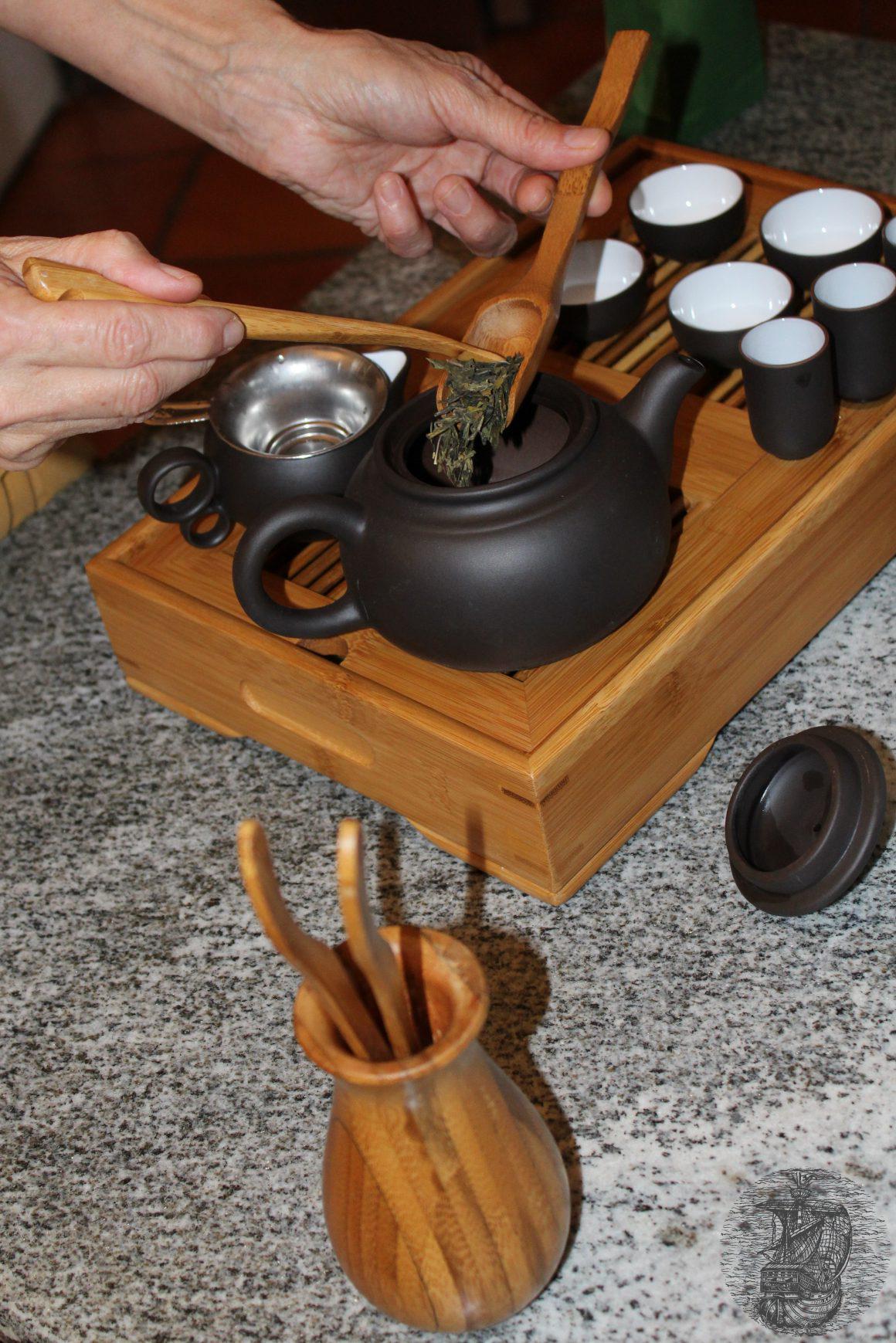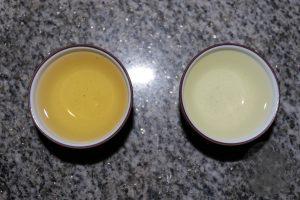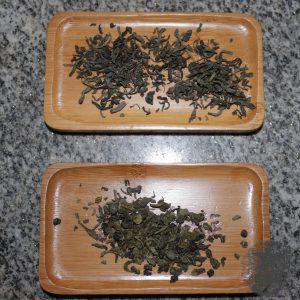
Various green teas from China and Japan
Green teas are very important in China and Japan
Green teas are consumed in large quantities in both countries.
However, the processing is different in each country. In China, the oxidation is interrupted with dry heat while in Japan moist heat is used. The tea is also cultivated and harvested differently. All this has an effect on the taste of the green tea.
More information about the Chinese way of enjoying green tea can be found here. And about the traditional Japanese way, here.
In this post, I will talk about some typical green teas from China and some from Japan

Right: Japanese greentea
Chinese green teas
Gunpowder
Gunpowder tea is manufactured in China or Taiwan. Each leaf is rolled up in itself and thus becomes a small ball. It is exactly its shape that has earned it the name Gunpowder. The Chinese name would be “pearl tea.” The infusion has a yellowish-green color and a fresh bitter taste. Gunpowder is the basis of the traditional North African mint tea.
Green Dragon from Yunnan
Green Dragon is a speciality of the Yunnan province in South China.
The leaf is green-grey and slightly rolled. The infusion is lovely and sweet.

Bottom: Green Dragon
Lun Ching
It has broad, pressed jade-coloured leaves and a delicate, flowery aroma. It gives a delicate, green infusion.
Flavoured green teas
In China, green teas were mainly flavoured with flowers such as jasmine, roses and osmanthus. Nowadays they are often flavoured with natural aromas (essential oils) or artificial flavours. There are always new creations and some flavoured teas have fantasy names.
Jasmine
Green jasmine tea is very valuable and is traditionally flavoured with fresh jasmine flowers. It is dried in layers by piling up fresh tea leaves and fresh jasmine flowers. The flowers are then removed by hand and the tea leaves are processed like any other green tea. Since this tea is very expensive, it is almost always flavoured with jasmine flavour nowadays.
Touareg
In the Touareg, gunpowder is flavoured with mint and mint leaves. This tea is traditionally drunk in North Africa – very sweet and very hot.
Tea Flowers
In China, you can also find elaborate tea specialties. For example tea spheres. Here the tea leaves are bound together and shaped so that they become closed balls. Often a fresh blossom is worked into them. Chrysanthemums, jasmine and osmanthus are particularly suitable for this. They are then dried and keep their shape. If you put this ball in hot water, the leaves will open slowly and let the flower “blossom”. A treat for the eyes! They are especially beautiful to look at in a glass jug. For these “tea flowers” white tea is usually used, which does not become bitter in the water.
Tea Nests
Sometimes green tea is pressed into small nests, which slowly open in the water. Well known is the Toucha tea.
Japanese green teas
Sencha
It is the most drunk tea in Japan. It is fresh, tender and mild and gives a light green infusion.
Bancha
Bancha tea is harvested from the same plants as Sencha tea, but only towards the end of the season when the leaves are already large. The infusion has a yellowish-green colour and a fresh, light taste. Like almost all Japanese teas, it tastes slightly grassy and fresh. It contains less theine than most other green teas.
Matcha
Matcha is a Japanese green tea powder made only from the leaves without veins (Tencha). It is used in Japan as tea for ceremonies. Nowadays Matcha is also used for cooking, e.g. for making Panna Cotta or for making beverages like cold or hot Matcha milk.
Powdered tea is very delicate and the only tea that should be kept in the refrigerator or freezer.
Gyokuro and Kabusecha
They are called shaded tea because the bushes are covered with straw mats or nets (in Japanese: kabuse) a few weeks before harvesting. This way the plants produce more chlorophyll and caffeine, but less bitter substances. Matured in this way, you get a soft tea. These are very valuable and expensive teas. Kabusecha can also be found in powder form, but unlike Matcha, it is ground from leaves with veins.
Genmaicha
The basis of this Japanese speciality is Bancha tea, to which roasted rice and popped rice is added. It is tasty with a sweet to salty taste and is usually enjoyed with a meal.

Bottom: Sencha
Kukicha
It is made only from the leaf veins, sometimes it is also found roasted.
In Japan less flavoured green tea is drunk, but of course, there are also flavoured Japanese green teas that are produced for export. And there are of course no limits to imagination. The flavours vary from flowery to fruity and spicy.
Which green tea do you like best?





2 Comments
Isa
Where do you buy your teas?
Sapori del Mondo
Hi, I buy them from an importer in Switzerland.